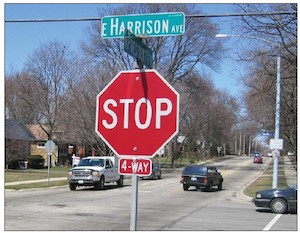| In English !?
After five years of publishing this blog in Flemish (Dutch), I decided to tack and start writing in English. An unbelievable journey across the world has lead me to get to know a group of Australian pharmacists that I want to offer the opportunity to follow not only what I do, but also the thoughts I want to share. And furthermore after 23 editions the next Pharmaceutical Management Course of IFB will start (next October) in English and on a new location. Reasons aplenty to write and share in a language everybody can understand. And for all: please use the red “REACT” button, below. Whether you agree or not: use “the art of voice” ! | It took me some time to understand the concept of the traffic sign “STOP ALL WAY” (or “STOP 4 WAY”). And then it dawned on me that this simple and cheap safety rule at crossroads in the United States helps to understand a basic rule in network collaboration. In a ‘flat”, non hierarchical organisation, such as a network, how does one determine who should “give way” to the interests of others ? How do you determine priorities ? STOP ALL WAY gives the answer. | In July we toured a couple of weeks trough South-Western USA. As a European, it took some time to (re)adjust to the “Stop All Way” signs and I never got around to understand how you can turn right at a red light. I quickly learned to look for traffic lights beyond the crossing. You don’t stop “at” the light. I had to figure out where you were supposed to stop, long enough before. Luckily enough, my wife was a constant reminder and guide in these matters, probably saving a lot of American lives and avoiding serious injury during our trip. | |  | New rules for new environments
Network collaboration is fun. It’s far more efficient than classical “contractual” collaboration because you don’t need a lot of red tape. Writing statutes and first putting into place precise internal rules and intricate businessplans slow down classical forms of collaboration. At least a bunch of contracts and precise one-to-one agreements have to be arranged before you can even start working. ‘Networking’ projects allows participants to come on board and “hop off” more easily. Typically objectives and action plans are dynamically readjusted “on the fly”. Supple spin-offs allow new projects to be added without restraint. ‘Networking’ creates a whole new environment in which to operate. That requires some new rules. In one of the next blogs, I will tell you about the 8 basic rules of network collaboration that have helped me to develop speed and results in all the – smaller and larger – projects I have participated in over the last years. But let’s get back to “STOP ALL WAY” first. On the road
In Europe the STOP sign is only used when secondary roads cross main roads. You have to stop and give way until it is safe to move on. In the US the same STOP is used, but with a FOR ALL (or 4 WAY) add-on. It is put on all four sides of the same crossing. All vehicles arriving at the crossroad have to come to a full stop (even if nobody else seems to be around !) and then cross in the order they arrived: first come, first served. As I said: it took some time to get used to the fact that after stopping, you have to figure out who arrived and stopped first. At first glance it slows down the flow of traffic, certainly if you get to a number of consecutive STOPs. You have to be more alert and look out for other drivers. And together you have to make choices without much fuss or doubts. A good dose of gentlemanship and some empathy can help. If you’re not in a hurry, you can also wave your priority. After a couple of days of practice on the road, I got it more or less right. It dawned on me how similar things are when you work together in a network. Getting across decision crossroads
Partners in network collaborations typically start working towards a common goal, without first establishing all the minute rules for each and every contingency. Often action plans will change when new partners come aboard; new opportunities are discovered; unexpected obstacles are encountered. At regular intervals “decision crossroads” have to be dealt with when several participating parties are confronted with new challenges that require rapid, just and equitable decisions. Each one arrives at these “crossroads” with his own priorities and interests. Since you haven’t planned every contingency in advance, you need a good rule of thumb to get across these decision “crossroads”. That’s when STOP ALL WAYS comes in handy. Just like on the road, everyone should stop and acknowledge and respect each other. As on the road, each direction can be the first to get right of way, depending on a simple and automatic ruling that is respectfully executed without external monitoring. If an issue is not important to you, wave your priority; you accumulate credit with your partners that might come in handy later. Yes, but…
Well it’s true: on the road it looks simpler, since it is just the first to arrive that gets priority. But looking a bit closer, some other rules apply when more complex situations have to be dealt with: several cars arriving at the same time; cars that have to turn left or right; rows of cars that have been waiting for some time before it’s their turn to cross; etc. I won’t go into detail what the code of conduct says, but a number of logical algorithms govern these situations, leading to an equitable and all-in-all rapid solution for everyone. And that’s exactly why I saw an analogy with “decision crossroads” in networking. Work out some logical and equitable rules how you get to decisions rapidly, making sure there are no constant losers or winners and get on with it. “Speed” and “Trust” are the cornerstones of every successful network. STOP ALL WAYS, decide and get on with it will get you to your objective and goals more easily. Dirk BROECKX – 7 august 2015 (Download a printable pdf of this edition : CLICK HERE) | PS: … and always stay creative ! While looking for an illustration, I couldn’t help but smile and agree with the guys that made this variation to the same theme. | | 
| | 
